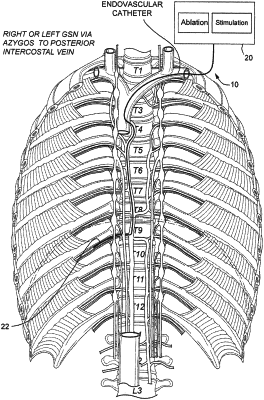| CPC A61B 18/1492 (2013.01) [A61N 1/00 (2013.01); A61N 1/36017 (2013.01); A61B 2018/00214 (2013.01); A61B 2018/00404 (2013.01); A61B 2018/00434 (2013.01); A61B 2018/00791 (2013.01); A61B 2018/00863 (2013.01); A61B 2018/00875 (2013.01); A61B 2090/064 (2016.02)] | 13 Claims |

|
13. A method of ablating a greater splanchnic nerve to treat a patient diagnosed with heart failure, comprising:
advancing a guidewire through an azygos vein and into a T9, T10, or T11 intercostal vein;
positioning an endovascular catheter comprising a proximal region, a flexible shaft, and a distal region, wherein the flexible shaft connects the proximal and distal regions and has a length adapted and sufficient to access an azygos vein space of a T9, T10, or T11 vertebra of the patient relative to an access location when the proximal region remains external to the patient, the distal region comprising one or more ablation elements;
advancing the distal region over the guidewire, through the azygos vein into the azygos vein space of the T9, T10, or T11 thoracic vertebra;
activating the one or more ablation elements;
delivering ablative energy to the greater splanchnic nerve using the one or more ablation elements; and
removing the endovascular catheter from the patient.
|